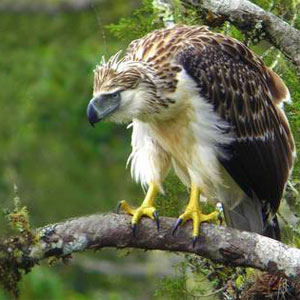Trivia about the National Bird, the Philippine Eagle
 Pithecophaga jefferyi, more popularly known as the Philippine Eagle or Monkey-Eating Eagle, is the world’s second largest and second rarest eagle. lts diet consists of monkeys, large snake, horn bills, civet cats and flying lemurs, Endemic to the Philippines, it is now found only in the forested mountains of Luzon, Samar, Leyte and Mindanao.
Pithecophaga jefferyi, more popularly known as the Philippine Eagle or Monkey-Eating Eagle, is the world’s second largest and second rarest eagle. lts diet consists of monkeys, large snake, horn bills, civet cats and flying lemurs, Endemic to the Philippines, it is now found only in the forested mountains of Luzon, Samar, Leyte and Mindanao.
The Eagle nests once every 2 years and lays only one egg which is incubated alternately by both the male and female for about 60 to 65 days. The eagle remains in the nest up lo 5-112 months. Once the young eagle fledged, the parents look after it lor as long as 17 months.
In signing Proclamation No.615, President Ramos made the Philippine Eagle the’flagship species in the conservation of Philippine wildlife”. The declaration of the Philippine Eagle as the National Bird has been supported by wildlife biologists who believe this could save the eagle from extinction. Prior to the proclamation, it was predicted that the Philippine Eagle could be extinct after 25 years, but now it is hoped that it will remain the National Bird for a longer period if not forever.
The areas are mostly located in the wilderness of Mindanao and Sierra Madre. Only 73 Philippine Eagles are known today, with 19 in captivity and thriving in the breeding centers in Davao City and Los Banos, Laguna.
Stamps and First Day Covers will be available starting December 5 & 10, 1997 at the Philatelic Division, Money Order Building, Liwasang Bonifacio, 1000 Manila and all Regional Offices of the Philippine Postal Corporation
Recent Comments